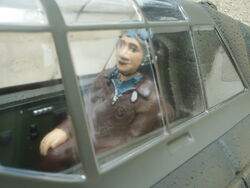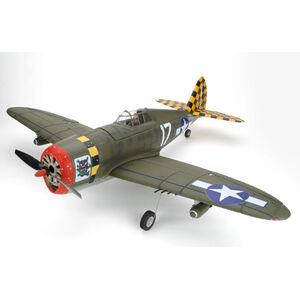
Detail photo of the hand-painted, pre-installed pilot figure and canopy
The E-flite P-47D Thunderbolt 400 is an intermediate to advanced electric-powered almost ready-to-fly foam park flyer-class airplane designed, manufactured and distributed by E-flite, a division of Horizon Hobby of Champaign, Illinois, USA.
Introduced shortly before the 2005 holiday season, the P-47D is E-flite's first scale warbird. Injection molded in CA-compatible EPS foam, the subassemblies of the P-47D are fully painted and decorated as is a pilot figure. Injection molding allows for deep, crisp, prototypically correct panel lines; an assembled P-47D makes an attractive static model when not in use. An interesting detail may be observed around the engine cowl. Speckles of aluminum-colored paint represent the chipped paint often seen on the prototype. The aileron servos and their wiring harnesses are hidden from view by vacuum-molded covers attached with Velcro and simulated machine gun barrels come pre-installed on the leading edges of the wing. The paint scheme with its distinctive yellow and black checkerboard pattern represents an actual aircraft flown in the spring of 1944 in Foggia, Italy by flying ace Lt. Cecil O. Dean of the 317th Fighter Squadron/325th Fighter Group of the Fifteenth Air Force. A similar plane, number 11, was flown in that same squadron by Herschel "Herky" Green (1920-2006), another of World War II's greatest aces.
The model is designed for easy and quick final assembly. Control surfaces come pre-installed as do a carbon fiber wing spar, the pilot, the canopy, motor mount, all decals and control horns. Pushrods are precut with Z-bends and pre-installed clevises. Landing gear wheels and tires are pre-mounted as well; Horizon Hobby claims that the P-47D can be assembled and flight ready in two to four hours. Several propulsion setup options are discussed in the instruction manual and the plane can be built with or without the included landing gear and simulated, wing-mounted bombs and pylons. Because of the various propulsion options available, a stick of modeling clay is included to help weight the nose in order to achieve the proper center of gravity. The balancing points are clearly marked with the letters "CG" on top of the wing. The rudder, tail and fuselage are molded as a unit and requires the rudder be cut from the tail, then trimmed and hinged in order to make it functional.
The recommended setups and their catalog numbers are:
- Use of the brushed 480 and gearbox included with the kit
- 4200kv E-flite Park 400 inrunner brushless motor (EFLM1100) with a change from the enclosed 56-tooth spur to a 65-tooth spur (EFLM243), 10-tooth pinion (EFLM1951) and Park 400 heat sink (EFLM1912)
- 920kv E-flite Park 400 outrunner (EFLM1305)
- 890kv E-flite Park 450 outrunner (EFLM1400)
An adapter to allow use of an outrunner is included with the kit. Use of the included 10x8E propeller is recommended for all but the geared 4200kv setup for which E-flite recommends the use of their 11x7 slow-flyer prop (EFLP1170, sold in packs of two) and enclosed large-to-small hex adapter. A 5/32" drill is required to ream out the propeller. Should one wish to use an APC-styled prop with the supplied gearbox, a suitable adapter is provided although the manual makes no mention of it.
Writing on a P-47D discussion group at rcgroups.com under the user name "dribbe," Horizon Hobby designer David Ribbe explained that the modular gearbox itself is unique to the P-47. He writes:
FWIW, The gearbox in the P-47 is all new. The shaft in the included gearbox is 4mm. It is quite strong. The gearbox is designed to be quite heavy duty, and allow for growth. The tooth is .8 module which is quite strong. We have flown the gearbox in other planes with other motors up to 320 watts, and the gear mesh is just fine. It was run extensively in Mini Edges up to 240 watts (6.5:1) with a Park 400 inrunner. We have flown it in a 'prototype' aircraft with a 6 pole motor at 320 watts (2.95:1). The gearbox is of quite good quality, and I expect it go gain a good reputation. It is very versatile as well, with multiple bolt patterns. Glad to see you guys enjoying the P-47. It is a great flyer.
Flight characteristics[]
Flight characteristics are very much to scale with the enclosed power setup. Use of the recommended high power setups greatly improves top speed without sacrificing manueverability; the 4200kv E-flite Park 400 and enclosed gearbox will cause the plane to become airborne in roughly 10' (3m) of runway if the landing gear is installed. Vertical capability, while not unlimited, is more than adequate with either brushless setup. Top speed of the geared brushless setup is approximately 50 mph (80 km/h).
Once airborne, the P-47D is nearly as stable as a trainer yet highly responsive, capable of virtually all basic aerobatics including near-effortless inverted flight and outside loops. If the plane is built with a functional rudder, stunts like hammerhead turns and four-point rolls are possible, although a fast four-point may be accomplished with ailerons alone. Knife edge flight is virtually impossible since the scale rudder lacks the necessary area. It is, however, a tremendous help against adverse yaw on both takeoff and landing. The P-47D tends to drop rather quickly when throttled back, so landings should be done under power. Once on final, the plane glides easily and may come in "hot."
Likes and dislikes[]
A number of individual "likes and dislikes" have been discussed in the forums linked below. Please bear in mind that the following are individual opinions and may not necessarily reflect the facts. "Likes" include:
- Scale looks and detail
- Outstanding fit and finish
- Optional four-channel control
- Exceptionally stable, especially for a low-winged warbird
- Choice of power setups
- High-quality gearbox
- Stable flight characteristics
- Excellent parts availability
- Unparalleled customer service
- Affordable cost
"Dislikes" include:
- Parts may break along the sharply detailed panel lines on a hard landing
- Vertical stabilizer and rudder are molded as a unit with the fuselage and must be replaced as a unit
- Weak factory adhesive bonds throughout the model which actually create more work for the builder
- Pre-installed motor mount stick makes it difficult to trim it to fit an outrunner
- Edges of the canopy are easily damaged upon removal
- Some hard-to-interpret photos in the instruction manual
- Scale covers on the undersides of the wing may come loose in flight
- Thin, unreinforced ailerons tend to fail around the control horn area; replacements are available only with the wing kit
- Pilot figure may be too small
- Pilot sits with hands on knees; no control stick detail
- "Stars and bars" decals are an odd, purplish hue
- No touch-up paint is provided or available
Specifications[]
- Wingspan: 39" (990mm)
- Length: 32" (813mm)
- Wing area: 260 sq in (168 sq cm)
- Flying weight: 21–26 oz (595-737g)
- Stock propulsion: Geared 480 with 10x8E propeller
- Radio requirements: Three-channel or greater; at least four-channel if rudder is used
- Recommended servo: E-flite S-75 7.5-gram sub-micro (EFLRS75) or equivalent; a 6" Y-harness (JR JSP98020 or equivalent) is required to operate the aileron servos via a single channel
- Recommended ESC: 20-ampere brushed (Castle Creations Pixie-20 CSEP20P or equivalent) or 20-ampere brushless (E-flite EFLA311B or equivalent)
- Recommended battery: 2100mAh 3S lithium polymer (Thunder Power THP21003SPL or equivalent) or nine-cell 1000mAh nickel metal hydride (ParkZone PKZ1027)
- Catalog number: EFL6000
- Average price: US$79.99
